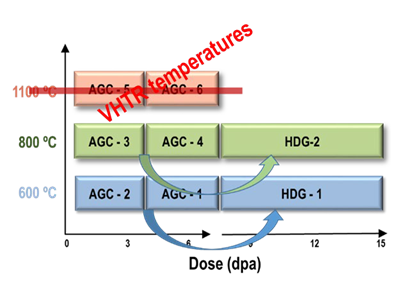Advanced Graphite Creep (AGC) Program
The Advanced Grapgite Creep program is the graphite irradiated material property testing program of the
DOE-ART Graphite R&D Program. The Baseline Program provides a large database of unirradiated material property data for each of the graphite grades used within the AGC experiments. The major objective of the irradiation experiments is to provide irradiation creep data. This requires matched pairs of stressed and unstressed specimens to be irradiated. This is achieved using the axial flux symmetry in ATR, with a stressed specimen above the symmetry plane matched to an unstressed specimen placed below the symmetry plane. This arrangement is used in six channels around the periphery of a graphite experiment capsule with a center channel used for additional unstressed specimens. Four irradiation experiments have been completed to date - AGC-1, AGC-2, AGC-3, and AGC-4.
In 2018, the Department of Energy (DOE) ART graphite program approved a major design change to the AGC experiment, extending the neutron dose range from 0–7 dpa to 0–15 dpa—a dose range more pertinent to current HTR designs. This neutron dose increase will extend current nuclear grades past turnaround dose levels and into a non-linear (tertiary) creep regime. To achieve this higher maximum dose level, the last two irradiation capsules, AGC-5 and AGC-6, were repurposed for irradiation at VHTR conditions of 1100°C. Under the new direction (2018), the AGC-5 and AGC-6 capsules will be used to irradiate previously exposed specimens from AGC-2, AGC-3, and AGC-4 once they have undergone PIE (below figure). AGC-5 will be renamed “High Dose Graphite-1” (HDG-1) and will re-irradiate AGC-2 specimens at a nominal irradiation temperature of 600°C. AGC-6 will be renamed “HDG-2” and will re-irradiate selected specimens from AGC-3 and AGC-4 at a nominal irradiation temperature of 800°C. No graphite specimens will be irradiated at temperatures of 1100°C. Once irradiation is complete in HDG-1 and HDG-2, all specimens will undergo a second PIE testing to determine how this higher dose level affects material properties.

Reports and Data
Publicly available reports describing results of the graphite characterization program are provided in this
Sharepoint Library.
An interactive Graphite Characterization Data Portal, which aids in data review and selection is available to users who
register with INL's Nuclear Data Management and Analysis System (NDMAS).


